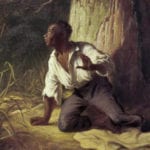 Food
Food  Food
Food  History
History 10 Odd Things Colonial Americans Kept at Home
 Weird Stuff
Weird Stuff 10 Superstitious Beliefs That Once Consumed Entire Cultures
 History
History 10 Bizarre Friendly Fire Incidents in Military History
 Technology
Technology 10 Modern Technologies That Accidentally Imitate Ancient Magic
 Mysteries
Mysteries 10 Mysteries of the Human Genome
 Weird Stuff
Weird Stuff 10 Things So Rare They’ve Only Been Found Once
 History
History 10 Legends Whose Last Moments Undid Their Glory
 Health
Health 10 Futuristic Ideas to Treat Common Medical Problems
 Weird Stuff
Weird Stuff Ten Surreal Attempts to Reverse Baldness
 Food
Food 10 Everyday Foods You Didn’t Know Were Invented by the U.S. Military
 History
History 10 Odd Things Colonial Americans Kept at Home
 Weird Stuff
Weird Stuff 10 Superstitious Beliefs That Once Consumed Entire Cultures
Who's Behind Listverse?

Jamie Frater
Head Editor
Jamie founded Listverse due to an insatiable desire to share fascinating, obscure, and bizarre facts. He has been a guest speaker on numerous national radio and television stations and is a five time published author.
More About Us History
History 10 Bizarre Friendly Fire Incidents in Military History
 Technology
Technology 10 Modern Technologies That Accidentally Imitate Ancient Magic
 Mysteries
Mysteries 10 Mysteries of the Human Genome
 Weird Stuff
Weird Stuff 10 Things So Rare They’ve Only Been Found Once
 History
History 10 Legends Whose Last Moments Undid Their Glory
 Health
Health 10 Futuristic Ideas to Treat Common Medical Problems
 Weird Stuff
Weird Stuff Ten Surreal Attempts to Reverse Baldness
10 Interesting Facts About The Mysterious D.B. Cooper Case
On a cloudy afternoon in November 1971, a well-dressed middle-aged man boarded a domestic flight leaving Portland, Oregon. Soon after the plane took off, the man calmly alerted air hostesses to a bomb he had wired inside his briefcase and communicated his ransom demands to the police on the ground. The man, who had used the name “Dan Cooper” to board the plane, eventually ended up with $200,000 in cash from the police.
After requesting the crew to take off again, he proceeded to jump out of the plane and into the night. He was never seen again. Here are ten interesting facts about the man the media (incorrectly) dubbed “D.B. Cooper.”
10 He Was Never Identified Or Found
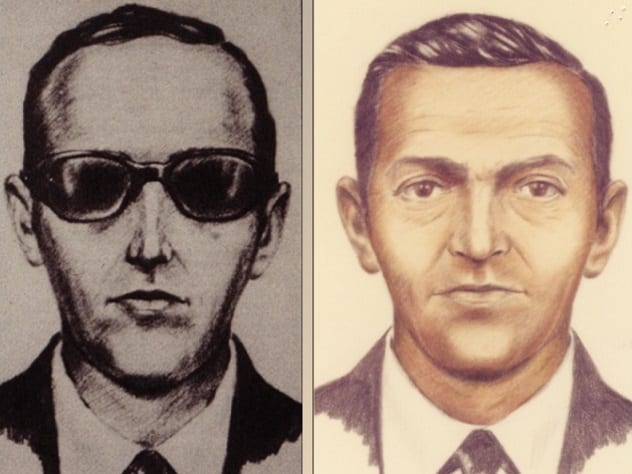
The most mysterious fact surrounding the hijacking in November 1971 is that the FBI never identified the man. It remains the only unsolved air piracy crime involving a commercial airliner.[1] The man described by witnesses jumped out of the airplane after the second takeoff and was never seen again.
Multiple theories exist as to his identity. Some theories suggest that infamous hijacker Richard Floyd McCoy Jr. was the culprit. In 1972, McCoy hijacked a commercial airliner and demanded a $500,000 ransom. He then proceeded to jump out of the plane, much like D.B. Cooper did. McCoy was caught and later killed after escaping prison. He was never definitively proven to be Cooper, and the FBI had doubts about him.
Other culprits include Kenneth Christensen, whose brother identified him as Cooper and who also bore a strong resemblance to the FBI drawing, and Jack Coffelt, who sustained leg injuries in the Portland area during the time and claimed he was Cooper. Although many suspects have existed, none have ever proven beyond a reasonable doubt to be Cooper, and in 2016, the FBI publicly announced that they were suspending the investigation.
9 His Description Sounded Like James Bond

Part of the sensation surrounding the D.B. Cooper hijacking is due to the fact he sounded so smooth. The official FBI bulletin that was released described him as a white male, mid-forties, with an olive Latin appearance and a well-spoken, intelligent demeanor. He was wearing a dark suit with a white shirt and black tie, carried a briefcase, and was at times wearing sunglasses.
According to one of the key witnesses, stewardess Florence Schaffner, Cooper was calm and even ordered two bourbons during the flight. Cooper even paid his bill and wanted to let Schaffner keep the change! He also calmly explained his plan to the pilots—he needed them to follow his instructions so that he could safely jump out of the plane. To completely round out the “James Bond” appeal, Cooper ended the hijacking by jumping out of the back of the plane with his parachute and the $200,000 in ransom money strapped to him.[2]
8 He May Have Posed As An Agent Working On A Movie

The investigative files were released by the FBI to the general public in 2016, and they make for fascinating reading. One of the details that is relatively unknown is that a man matching Cooper’s general description had conducted some discussions with pilots about how to safely and accurately “drop an object” from a moving airplane to an accomplice below. The man’s description resembled that of Cooper’s; he was wearing a smart business suit, had a low, well-spoken voice and low sideburns, and stood around 183 centimeters (6′) tall.
According to the FBI reports, two weeks prior to the November hijacking, the unidentified man sat between the two pilots and claimed he was working on a new movie script. He handed out brochures of his existing movies. He specifically wanted to know the best way to accurately drop an object to a waiting accomplice below. He was told by the pilots that flying at as low a speed and altitude as possible, with the cabin depressurized, was the best chance of accuracy. Upon FBI investigation, the pilots could not recall the name of the movie studio, the films, or the name of the new movie the man was working on.[3] The man was never identified.
7 There’s A Good Chance He Died While Escaping

Imagine jumping out a moving airplane in the middle of the night, with over 9 kilograms (20 lb) of money strapped to you, into the cold November weather. This is what the hijacker did. Cooper reportedly jumped out of the back of the plane over the dense forest near Mount St. Helens, in Washington state. Cooper would have been landing in an unknown area and would have likely suffered ankle or leg injuries (or worse).
According to the FBI investigation files, master parachute rigger Earl J. Cossey stated that Cooper would have been completely unable to control his rate of descent. Seattle case agent Larry Carr said about the jump, “Diving into the wilderness without a plan, without the right equipment, in such terrible conditions, he probably never even got his chute open.” Even though most assume he did not survive the landing, no parachute debris or remains of Cooper were ever discovered in the wide search zone. Lakes and rivers were swept to no avail. Another curious fact is that despite a total of five planes tailing the Boeing 727, none of the pilots could say they witnessed Cooper jumping from the plane.[4]
6 He May Have Given An Interview With A Local Newspaper
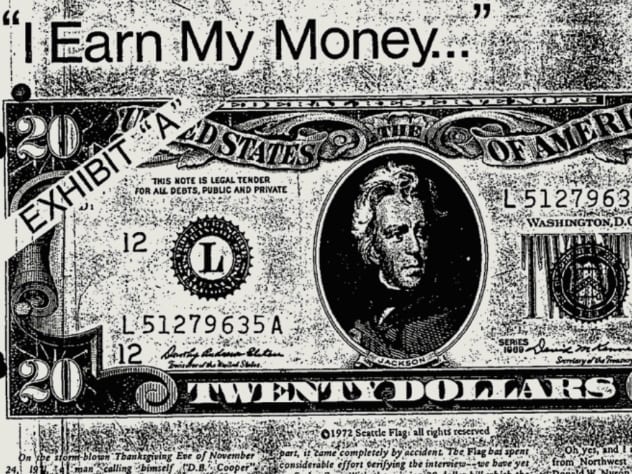
It’s a little-known fact that in 1972, the Seattle Flag newspaper published an interview that they claimed was with the real man who hijacked the plane. Their proof, you ask? They claimed to have one of the $20 bills supplied to Cooper by the police—they even published an image of the purported bill.[5] The newspaper also claimed they had gone to considerable effort to verify the source.
The interview itself is fascinating. The man claims that he opened the rear door of plane, walked down to the tenth step, and then jumped out into the cold. He claimed he buried his parachute and was a “few miles” off from his intended landing spot. Interestingly, the man declined to answer a question about having an accomplice waiting on the ground. He also claimed the bomb was a fake—his suitcase contained Gillette shaving cans painted red, with wires rigged into them. He revealed that the riskiest part of the hijacking occurred when the plane was refueling on the ground, and authorities were deliberately stalling.
At the end of the interview, the man said he was going to disappear for at least five years and would only return after the statue of limitations had expired. (Note that Cooper was later indicted in absentia in such a way that prosecution can go forward no matter when he’s caught.)
5 He’s Become A Plot Device In Modern Entertainment
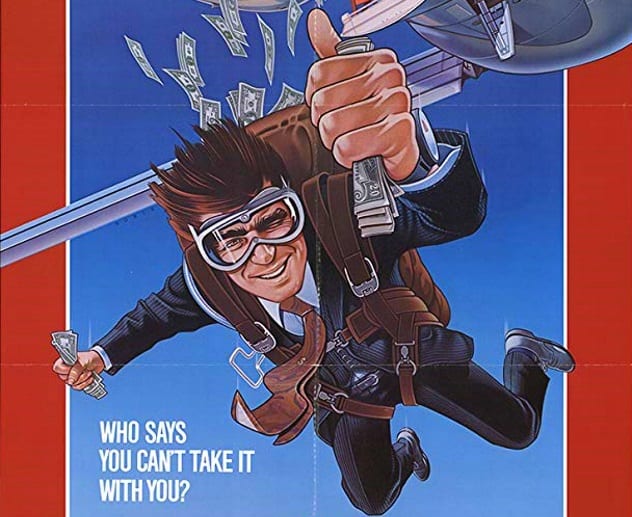
The Cooper saga has been sensationalized, and he has become a very widely used character in both television and film. Cooper is more often portrayed as being alive than deceased. In the TV series Prison Break, a character within the prison proves he is the real hijacker by presenting one of the stolen bills. In the film Without a Paddle, the main characters go in search of Cooper and his money in Washington state, and they end up finding his remains alongside $100,000. (Cooper burned the other half to keep warm.)
In 1981, The Pursuit of D.B. Cooper was released—the first feature film depicting the hijacking and its aftermath.[6] Interestingly, in this version of events, Cooper escapes after landing, using a Jeep he’d hidden in the woods. He is then later assisted by his estranged wife. Other shows that have fictionalized Cooper include Renegade, Numb3rs, Lethal Weapon, and Justified.
4 Some Of The Money Was Found Years Later
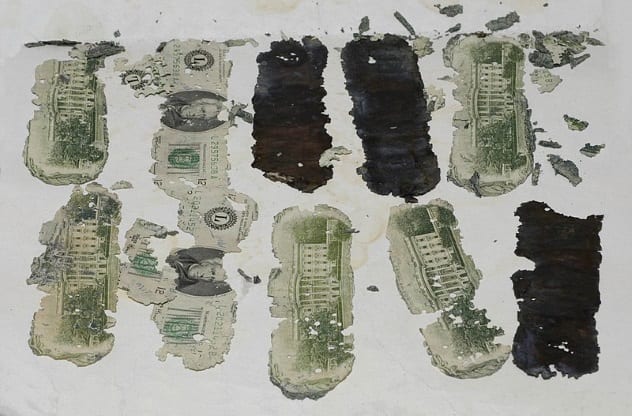
In February 1980, an eight-year old boy who was on vacation near Vancouver, Washington, uncovered some of the bills while raking through a sandy riverbank. They were still bundled as they had been when provided to Cooper in 1971. Although they had degraded over the years, FBI technicians confirmed they were, in fact, a portion of Cooper’s money. The location of the discovery was about 14 kilometers (9 mi) from the theoretical landing position of Cooper. Noticeably, one of the three 100-bill stacks only contained 90 bills, which only raises more questions.
How did the bills get to the riverbank? Had they been there for years, or had they recently washed ashore? Were they deliberately buried by Cooper or an accomplice? None of the other bills have ever been reported in circulation and remain missing to this day.[7] However, in what is a feel-good element to this story, the boy was allowed to keep roughly half of the money he found that day and sold it at an auction in 2008 for over $37,000!
3 He Inspired 15 Copycat Hijackers In 1972

After the apparent success of Cooper’s hijacking, many others were inspired to try it in the following year. The most infamous of these copycats was Richard Floyd McCoy Jr., but there were many others who aspired to pull off what Cooper did.
One of the most interesting hijackings was committed by a man named Frederick Hahneman, who hijacked a plane taking off from Allentown, Pennsylvania, and demanded it to be grounded at Dulles so that his ransom could be met. His ransom included $303,000, cigarettes, food, parachutes, knives, fuel, and crash helmets. Once his demands were met, Hahneman allowed all the passengers and all but six of the flight crew to leave the plane. He then ordered the captain to take off again. Then he decided the $100 bills he had been given were too small of a denomination, so he ordered the plane to return to Dulles.
Four hours later, they took off again with $500 and $1,000 bills. During the flight, the plane experienced mechanical problems, and they had to land at New Orleans. They proceeded to switch planes, Hahneman using his handgun and hostages to shimmy along the runway. They took off again and flew to Honduras, where Hahneman jumped out into the dead of night, over the jungle, clutching his ransom. After being on the run for weeks, Hahneman later handed himself in to the US embassy in Honduras.[8]
A more unfortunate attempt was committed by Martin McNally, who, in June 1972, hijacked a plane from St. Louis and dropped his $500,000 ransom upon exiting the airplane!
2 He Changed Aviation Security Forever

After the Cooper hijacking and the subsequent copycat hijackings, aviation authorities and the FBI realized that the relaxed security on American domestic flights was too easy for hijackers. The first step to preventing hijackings was to introduce full baggage security checks for the first time. This might seen unbelievable in 2019, but the issue had to actually be passed through the US courts in 1973! American passengers thought these searches were a violation of their rights, but eventually, it was deemed necessary to protect those on board.
It also became mandatory for all cockpit doors to have a peephole so that the pilots could be aware of what was happening on the other side. Aviation authorities also created what is known as the Cooper vane—a device which prevents the aft stairs from being opened during flight.[9] (The example shown above is unlocked.) This would essentially make disembarking from a plane mid-flight in the the manner Cooper did impossible, and before long, hijackings began to become less frequent. Never again would the hijacking that D.B. Cooper committed be able to be repeated, and the device is forever named after him.
1 There’s A Chance He Could Be Alive Today
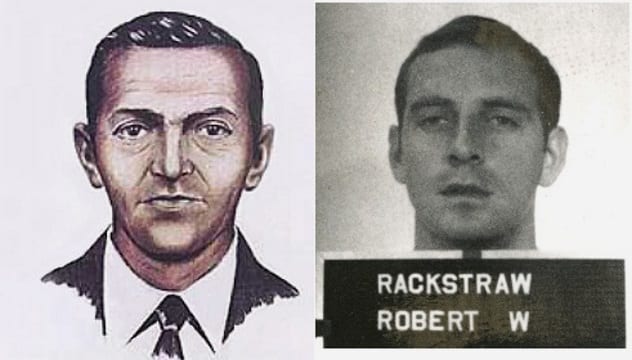
According to a 2016 book entitled The Last Master Outlaw, the man who hijacked the plane was Robert Rackstraw. Rackstraw, a Vietnam veteran pilot, is the subject of the book, which highlights his history of extreme aviation escapes as well as his uncanny likeness to the FBI sketch of Cooper.[10] In 1978, Rackstraw tried to fake his own death and was arrested. His skill set and experience alerted the FBI to him. They noticed the resemblance to the sketch, but they ultimately could not find enough physical evidence to make any direct connection to the crime.
Rackstraw himself reportedly admitted to being Cooper, but the FBI thought this was just a ploy. Rackstraw is still alive today. We may get a deathbed confession from him, but even that wouldn’t be the first time such a thing has happened in the mysterious case of D.B. Cooper.
I am a 28-year-old writer who has undergraduate degrees in both English Literature and in Law. I have written for Law publications (The Student Lawyer) in the past but now work full-time for a pharmaceutical company. I live in the United Kingdom with my wife and two-year-old boy, Lucas. My main aim is to enjoy writing about whatever I feel like writing about . . . and to make a little bit of money doing so. I hope the Listverse team likes my stuff and I warmly invite any feedback on my writing. Thanks !
Read about more elusive criminals on 10 Prison Escapees Who Eluded Capture For Decades and 10 Terrifying American Serial Killers Still At Large.






